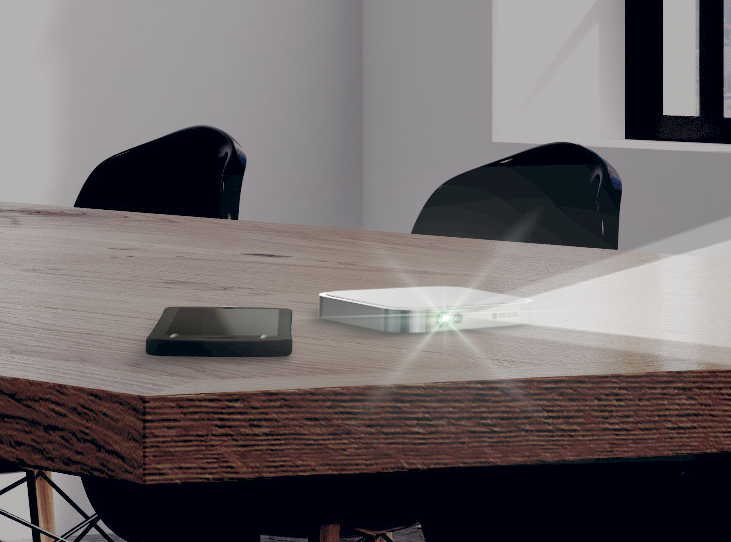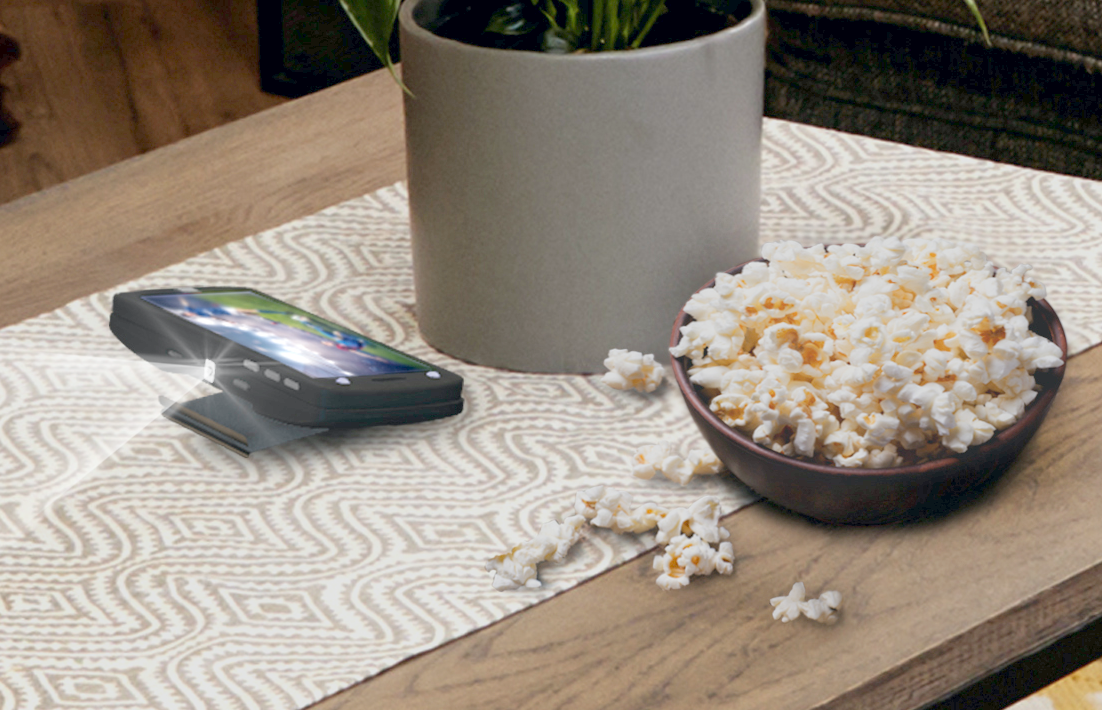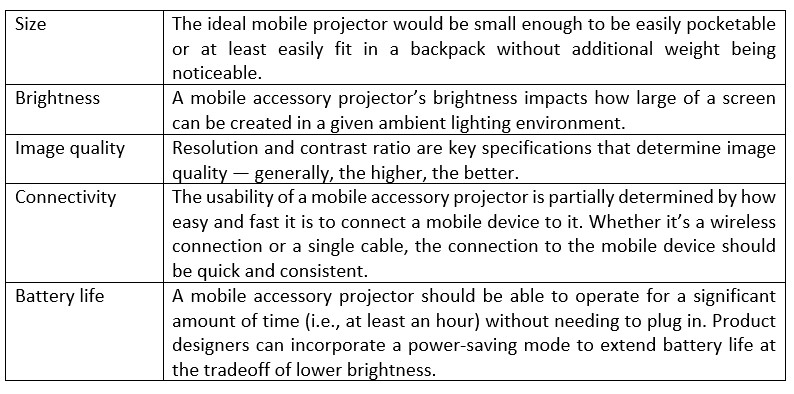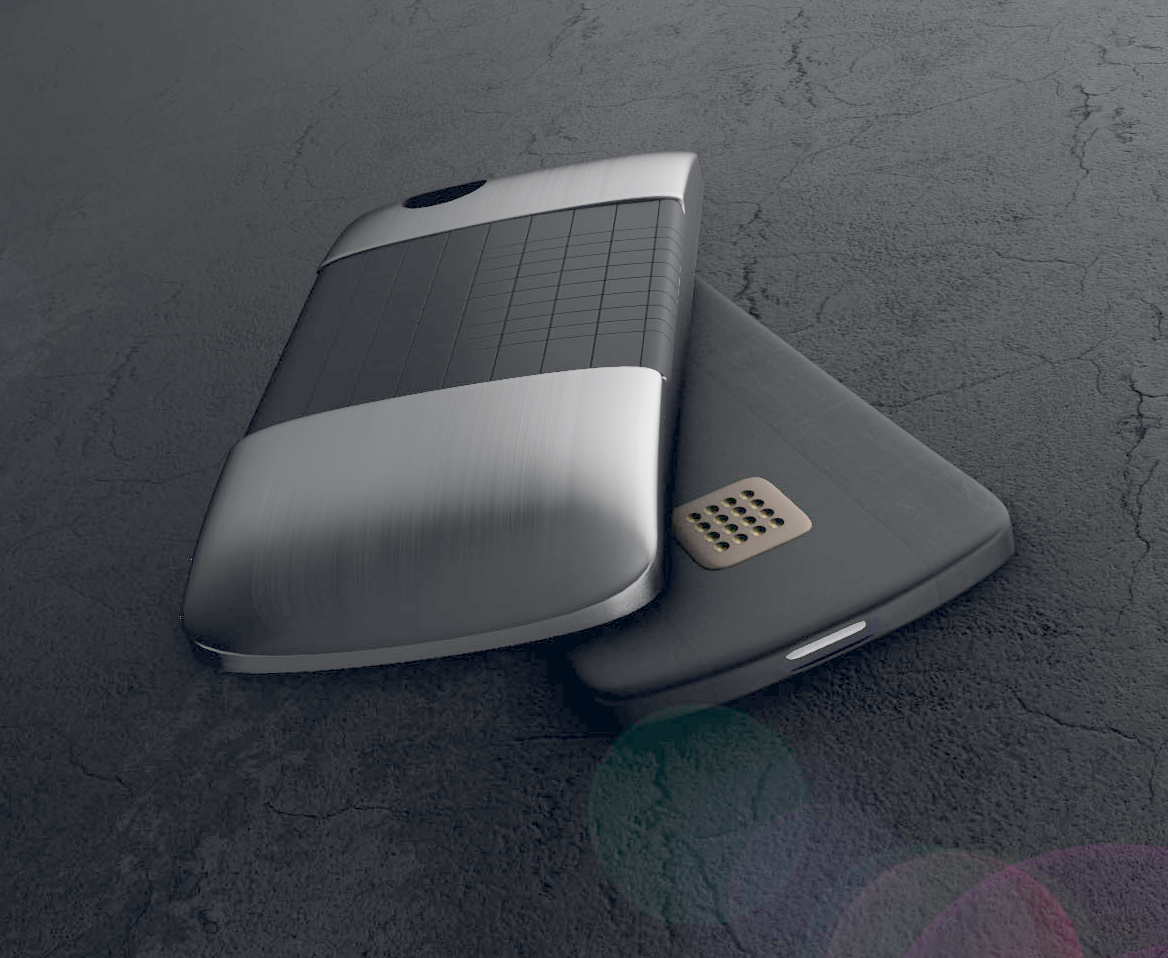By Jesse Richuso, product marketing engineer, Texas Instruments DLP Products group
The rapid adoption of mobile devices, such as smartphones and tablets, over the last decade has given billions of people around the world the ability to stream and share content virtually anytime, anywhere. However, smartphones and tablets must be pocketable and portable, respectively, and therefore have relatively small screens ranging from roughly 4 inches to 13 inches diagonal.
Viewing these small screens from a close distance for hours each day can cause eye strain . A portable solution to the small screen problem is a mobile accessory projector that can create a big, comfortable viewing experience virtually anywhere, anytime.

While you may think of projectors as large, heavy devices found in classrooms, conference rooms, and sports bars, new technology has enabled a new class of much smaller, lighter projectors. A mobile accessory projector is battery-powered and designed to quickly display a large projected image up to 60 inches diagonally in a dim room with content from a mobile device. The rise of mobile devices has thus enabled a large market for these small accessory projectors.
Benefits of mobile accessory projectors
A mobile accessory projector is a valuable product for mobile device users in several situations:
1. Spontaneous content sharing in a group
Smartphone users may find themselves in a group situation when someone wants to share a photo or video. They gather around closely to view or pass around the phone, trying to get a good look at a 5-inch to 6-inch diagonal screen from several feet away. Instead, a mobile accessory projector can quickly create a much larger image on a nearby surface.
2. Extended viewing sessions
When watching content for an extended period, such as a sporting event, TV episode, or movie, a large projected screen is not only great for sharing with others, it is also easier on the eyes because of the longer viewing distance compared to typical smartphone or tablet viewing distances. Plus, it’s not fixed to one location like a TV, which means that you can watch an episode of your favorite show on the ceiling of a hotel room, a wall in your home, or even outdoors on the side of your house.

3. Collaboration in the office
Laptops, tablets, and smartphones have become common computing tools, but their relatively small screens are not ideal for sharing with multiple viewers. A mobile accessory projector in an office can enable a worker to quickly share a larger version of his or her laptop, tablet, or smartphone screen on a nearby surface without the need to find a conference room.
Key specifications
There are several specifications that significantly impact the performance and usability of a mobile accessory projector.

Connectivity options
Connectivity to a mobile device is a key determinant in how easy a mobile projector is to use. Mobile accessory projectors can be connected in a variety of ways:
- Wireless connectivity: Many smartphones, tablets, and laptops have wireless connectivity standards that a mobile accessory projector can incorporate. For example, Android phones and tablets can take advantage of Google Cast, while Windows 10 PCs use Miracast.
- Modular attachment: A smartphone can be specifically designed with an external interface to enable modular attachments. One such example is the Motorola Moto Z series and its lineup of attachable accessories. A modular attachment makes connecting a mobile accessory projector fast and easy with the potential for automatic power-up and display.

- USB Type-C: The USB Type-C interface is growing in popularity due to its versatility. It can deliver power and data over one cable with a small connector. A mobile accessory projector can not only receive video via USB-C but also power, which can enable a very compact and lightweight battery-free design.
- HDMI: HDMI is the current standard for wired video interface and is found on most mobile accessory projectors today. HDMI ports can also accommodate popular smart streaming sticks, such as Chromecast, Amazon Fire TV, or the Roku Stick.
Product development and supply chain options
There are a few different ways to get started with development of a mobile accessory projector. You can find the right option for your company, depending on your company’s engineering capabilities and market goals.
1. White label products from a third-party ODM = Fastest time to market
A consumer electronics brand (or OEM) seeking to add a mobile accessory projector to its portfolio can find a complete product that can be quickly taken to market. An active ecosystem of ODMs can supply a mobile accessory projector that matches the performance and cost targets of the brand. Limited customization of the product may be available.
2. Custom product from a third-party system integrator = More customization
For customers looking for more customization, a mobile accessory projector system integrator can develop a new product based on specific requirements of the end customer. Features such as audio quality, connectivity, and product functionality can be customized.
3. New internal product design = Complete customization
For customers seeking to internally design a completely new product, an optical module manufacturer (OMM) can supply the core subsystem of the mobile accessory projector.
The evolution of projection technology has enabled incredibly small, light, and high-performance mobile accessory projectors that can create impressive image displays. With billions of smartphone, tablet, and laptop users in the world with <14-inch screens, the market for mobile accessory projectors is huge. Texas Instruments’ DLP Pico projection technology, which enables high image quality, high brightness, and high power efficiency, offers several development tools and support resources to get started .
About the author
Jesse Richuso is a product marketing engineer in the Texas Instruments DLP Products group, specializing in DLP Pico technology for mobile accessory projectors, AR/VR glasses, and smart home displays. He supports the Americas and European markets and has been with TI DLP Products for seven years. Outside of work, Jesse is passionate about gaming, baseball, and dogs.
Advertisement
Learn more about Electronic Products MagazineTexas Instruments





